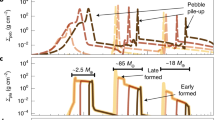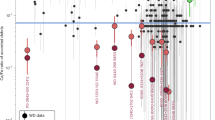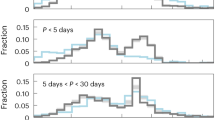Abstract
The formation of planetesimals is expected to occur via particle-gas instabilities that concentrate dust into self-gravitating clumps1,2,3. Triggering these instabilities requires the prior pile-up of dust in the protoplanetary disk4,5. This has been successfully modelled exclusively at the disk’s snowline6,7,8,9, whereas rocky planetesimals in the inner disk were only obtained by assuming either unrealistically large particle sizes10,11 or an enhanced global disk metallicity12. However, planetesimal formation solely at the snowline is difficult to reconcile with the early and contemporaneous formation of iron meteorite parent bodies with distinct oxidation states13,14 and isotopic compositions15, indicating formation at different radial locations in the disk. Here, by modelling the evolution of a disk with ongoing accretion of material from the collapsing molecular cloud16,17,18, we show that planetesimal formation may have been triggered within the first 0.5 million years by dust pile-up at both the snowline (at ~5 au) and the silicate sublimation line (at ~1 au), provided turbulent diffusion was low. Particle concentration at ~1 au is due to the early outward radial motion of gas19 and is assisted by the sublimation and recondensation of silicates20,21. Our results indicate that, although the planetesimals at the two locations formed about contemporaneously, those at the snowline accreted a large fraction of their mass (~60%) from materials delivered to the disk in the first few tens of thousands of years, whereas this fraction is only 30% for the planetesimals formed at the silicate line. Thus, provided that the isotopic composition of the delivered material changed with time22, these two planetesimal populations should have distinct isotopic compositions, consistent with observations15.
This is a preview of subscription content, access via your institution
Access options
Access Nature and 54 other Nature Portfolio journals
Get Nature+, our best-value online-access subscription
$29.99 / 30 days
cancel any time
Subscribe to this journal
Receive 12 digital issues and online access to articles
$119.00 per year
only $9.92 per issue
Buy this article
- Purchase on Springer Link
- Instant access to full article PDF
Prices may be subject to local taxes which are calculated during checkout




Similar content being viewed by others
Data availability
The compiled code, the input file and the ascii output files of our reference simulation including silicate condensation/sublimation (one file per output timestep (104 yr) for a total of 100 files) are provided at: lagrange.oca.eu/images/LAGRANGE/pages_perso/morby/forNature.tar.gz. A readme file describes the content of each file.
Code availability
The code for the calculation of the disk evolution is available on request from the corresponding author.
References
Youdin, A. N. & Goodman, J. Streaming instabilities in protoplanetary disks. Astrophys. J. 620, 459–469 (2005).
Cuzzi, J. N., Hogan, R. C. & Shariff, K. Toward planetesimals: dense chondrule clumps in the protoplanetary nebula. Astrophys. J. 687, 1432–1447 (2008).
Simon, J. B., Armitage, P. J., Li, R. & Youdin, A. N. The mass and size distribution of planetesimals formed by the streaming instability. I. The role of self-gravity. Astrophys. J. 822, 55 (2016).
Drążkowska, J. & Dullemond, C. P. Can dust coagulation trigger streaming instability? Astron. Astrophys. 572, A78 (2014).
Yang, C.-C., Johansen, A. & Carrera, D. Concentrating small particles in protoplanetary disks through the streaming instability. Astron. Astrophys. 606, A80 (2017).
Ida, S. & Guillot, T. Formation of dust-rich planetesimals from sublimated pebbles inside of the snow line. Astron. Astrophys. 596, L3 (2016).
Schoonenberg, D. & Ormel, C. W. Planetesimal formation near the snowline: in or out? Astron. Astrophys. 602, A21 (2017).
Drążkowska, J. & Alibert, Y. Planetesimal formation starts at the snow line. Astron. Astrophys. 608, A92 (2017).
Drążkowska, J. & Dullemond, C. P. Planetesimal formation during protoplanetary disk buildup. Astron. Astrophys. 614, A62 (2018).
Drążkowska, J., Alibert, Y. & Moore, B. Close-in planetesimal formation by pile-up of drifting pebbles. Astron. Astrophys. 594, A105 (2016).
Charnoz, S. et al. Planetesimal formation in an evolving protoplanetary disk with a dead zone. Astron. Astrophys. 627, A50 (2019).
Schoonenberg, D., Ormel, C. W. & Krijt, S. A Lagrangian model for dust evolution in protoplanetary disks: formation of wet and dry planetesimals at different stellar masses. Astron. Astrophys. 620, A134 (2018).
Chabot, N. L. Composition of metallic cores in the early solar system. 49th Lunar and Planetary Science Conference 2083 (ed. LPI) (2018).
Spitzer, F., Burkhardt, C., Nimmo, F. & Kleine, T. Nucleosynthetic Pt isotope anomalies and the Hf-W chronology of core formation in inner and outer solar system planetesimals. Earth Planet. Sci. Lett. 576, 117211 (2021).
Kruijer, T. S., Burkhardt, C., Budde, G. & Kleine, T. Age of Jupiter inferred from the distinct genetics and formation times of meteorites. Proc. Natl Acad. Sci. USA 114, 6712–6716 (2017).
Hueso, R. & Guillot, T. Evolution of protoplanetary disks: constraints from DM Tauri and GM Aurigae. Astron. Astrophys. 442, 703–725 (2005).
Pignatale, F. C., Charnoz, S., Chaussidon, M. & Jacquet, E. Making the planetary material diversity during the early assembling of the solar system. Astrophys. J. 867, L23 (2018).
Baillié, K., Marques, J. & Piau, L. Building protoplanetary disks from the molecular cloud: redefining the disk timeline. Astron. Astrophys. 624, A93 (2019).
Batygin, K. & Morbidelli, A. Formation of giant planet satellites. Astrophys. J. 894, 143 (2020).
Aguichine, A., Mousis, O., Devouard, B. & Ronnet, T. Rocklines as cradles for refractory solids in the protosolar nebula. Astrophys. J. 901, 97 (2020).
Miyazaki, Y. & Korenaga, J. Dynamic evolution of major element chemistry in protoplanetary disks and its implications for Earth-enstatite chondrite connection. Icarus 361, 114368 (2021).
Nanne, J. A. M., Nimmo, F., Cuzzi, J. N. & Kleine, T. Origin of the non-carbonaceous–carbonaceous meteorite dichotomy. Earth Planet. Sci. Lett. 511, 44–54 (2019).
Appelgren, J., Lambrechts, M. & Johansen, A. Dust clearing by radial drift in evolving protoplanetary discs. Astron. Astrophys. 638, A156 (2020).
Pinte, C. et al. Dust and gas in the disk of HL Tauri: surface density, dust settling, and dust-to-gas ratio. Astrophys. J. 816, 25 (2016).
Dullemond, C. P. et al. The Disk Substructures at High Angular Resolution Project (DSHARP). VI. Dust trapping in thin-ringed protoplanetary disks. Astrophys. J. 869, L46 (2018).
Lee, Y. N., Charnoz, S. & Hennebelle, P. Protoplanetary disk formation from the collapse of a prestellar core. Astron. Astrophys. 648, A101 (2021).
Güttler, C., Blum, J., Zsom, A., Ormel, C. W. & Dullemond, C. P. The outcome of protoplanetary dust growth: pebbles, boulders, or planetesimals? I. Mapping the zoo of laboratory collision experiments. Astron. Astrophys. 513. https://doi.org/10.1051/0004-6361/200912852 (2010).
Gole, D. A., Simon, J. B., Li, R., Youdin, A. N. & Armitage, P. J. Turbulence regulates the rate of planetesimal formation via gravitational collapse. Astrophys. J. 904, 132 (2020).
Hansen, B. M. S. Formation of the terrestrial planets from a narrow annulus. Astrophys. J. 703, 1131–1140 (2009).
Owen, J. E. & Wu, Y. The evaporation valley in the Kepler planets. Astrophys. J. 847, 29 (2017).
Izidoro, A. et al. Formation of planetary systems by pebble accretion and migration: hot super-Earth systems from breaking compact resonant chains. Astron. Astrophys. 650, A 152 (2021).
Morbidelli, A., Libourel, G., Palme, H., Jacobson, S. A. & Rubie, D. C. Subsolar Al/Si and Mg/Si ratios of non-carbonaceous chondrites reveal planetesimal formation during early condensation in the protoplanetary disk. Earth Planet. Sci. Lett. 538, 116220 (2020).
Tornabene, H. A., Ash, R. D. & Walker, R. J. New insights to the genetics, formation and crystallization history of group IC iron meteorites. 52nd Lunar Planetary Science Conference 2548. LPI (2021).
Hilton, C. D., Ash, R. D. & Walker, R. J. Crystallization histories of the group IIF iron meteorites and Eagle Station pallasites. Meteorit. Planet. Sci. 55, 2570–2586 (2020).
Stewart, S. T. et al. 2019. Collapsing impact vapor plume model for chondrule and chondrite formation. 50th Annual Lunar and Planetary Science Conference. LPI. (2019).
Lichtenberg, T., Drążkowska, J., Schönbächer, M., Golabek, G. J. & Hand, T. O. Bifurcation of planetary building blocks during Solar System formation. Science 371, 365–370 (2020).
Chiang, E. & Youdin, A. N. Forming planetesimals in solar and extrasolar nebulae. Ann. Rev. Earth Planet. Sci. 38, 493–522 (2010).
Dullemond, C. Theoretical Models of the Structure of Protoplanetary Disks. Lecture notes. Heidelberg Univ. (2013).
Bitsch, B., Morbidelli, A., Lega, E. & Crida, A. Stellar irradiated discs and implications on migration of embedded planets. II. Accreting-discs. Astron. Astrophys. 564, A135 (2014).
Kley, W., Bitsch, B. & Klahr, H. Planet migration in three-dimensional radiative discs. Astron. Astrophys. 506, 971–987 (2009).
Kley, W. Radiation hydrodynamics of the boundary layer in accretion disks. I. Numerical methods. Astron. Astrophys. 208, 98–110 (1989).
Rafikov, R. R. Viscosity prescription for gravitationally unstable accretion disks. Astrophys. J. 804, 62 (2015).
Birnstiel, T., Fang, M. & Johansen, A. Dust evolution and the formation of planetesimals. Space Sci. Rev. 205, 41–75 (2016).
Ormel, C. W. An atmospheric structure equation for grain growth. Astrophys. J. 789, L18 (2014).
Gonzalez, J.-F., Laibe, G. & Maddison, S. T. Self-induced dust traps: overcoming planet formation barriers. Mon. Not. R. Astron. Soc. 467, 1984–1996 (2017).
Carballido, A., Stone, J. M. & Pringle, J. E. Diffusion coefficient of a passive contaminant in a local MHD model of a turbulent accretion disc. Mon. Not. R. Astron. Soc. 358, 1055–1060 (2005).
Hyodo, R., Ida, S. & Charnoz, S. Formation of rocky and icy planetesimals inside and outside the snow line: effects of diffusion, sublimation, and back-reaction. Astron. Astrophys. 629, A90 (2019).
Burkhardt, C., Dauphas, N., Hans, U., Bourdon, B. & Kleine, T. Elemental and isotopic variability in solar system materials by mixing and processing of primordial disk reservoirs. Geochim. Cosmochim. Acta 261, 145–170 (2019).
Brennecka, G. A. et al. Astronomical context of Solar System formation from molybdenum isotopes in meteorite inclusions. Science 370, 837–840 (2020).
Budde, G., Burkhardt, C. & Kleine, T. Molybdenum isotopic evidence for the late accretion of outer Solar System material to Earth. Nat. Astron. 3, 736–741 (2019).
Acknowledgements
A.M. and S.C. acknowledge support from programme ANR-20-CE49-0006 (ANR DISKBUILD). The work presented here has been performed in preparation for the proposal HolyEarth by A.M. and T.K., which has been funded by the European Research Council (grant No. 101019380). The authors thank R. Deienno and C. Ormel for constructive and detailed comments.
Author information
Authors and Affiliations
Contributions
A.M. conceived the project, wrote the code, ran the simulations and led the writing of the manuscript. K. Baillié wrote an earlier version of the code. K. Baillié, S.C. and T.G. contributed with their experience on disk evolution. K. Batygin stressed the importance of the radial expansion of the disk. D.C.R. and T.K. provided their experience on the chemical and isotopic composition of meteorites, which allowed for testing the model against measured constraints. All authors contributed to writing the manuscript and discussing the significance of the results.
Corresponding author
Ethics declarations
Competing interests
The authors declare no competing interests.
Additional information
Peer review information Nature Astronomy thanks Rogerio Dienno, Chris Ormel and the other, anonymous, reviewer(s) for their contribution to the peer review of this work.
Publisher’s note Springer Nature remains neutral with regard to jurisdictional claims in published maps and institutional affiliations.
Extended data
Extended Data Fig. 1 Surface density of the disk.
Surface density of the disk as a function of heliocentric distance at different times.
Extended Data Fig. 2 Turbulent parameter α.
Turbulent parameter α, for the nominal simulation presented in the main text.
Extended Data Fig. 3 total masses of rocky and icy planetesimals.
total masses of rocky and icy planetesimals for 4 values of αmin and two values of Qlim.
Extended Data Fig. 4 Fraction of early material in CC and NC according to isotopic constraints.
Relation between fraction of early material in CC and NC as given by Ti and Mo isotope anomalies in meteorites. The thick solid line assumes the average value for NC meteorites ε50TiNC = –1 while the thin line assumes ε50TiNC = – 2 (that is the extreme value observed in NC). Orange-shaded area indicates the predicted fractions of our model: 0.275-0.3 for NC planetesimals and 0.450.70 for CC planetesimals.
Supplementary information
Supplementary Information
Supplementary Note, Figs. 1–4 and Tables 1 and 2.
Rights and permissions
Springer Nature or its licensor (e.g. a society or other partner) holds exclusive rights to this article under a publishing agreement with the author(s) or other rightsholder(s); author self-archiving of the accepted manuscript version of this article is solely governed by the terms of such publishing agreement and applicable law.
About this article
Cite this article
Morbidelli, A., Baillié, K., Batygin, K. et al. Contemporary formation of early Solar System planetesimals at two distinct radial locations. Nat Astron 6, 72–79 (2022). https://doi.org/10.1038/s41550-021-01517-7
Received:
Accepted:
Published:
Issue Date:
DOI: https://doi.org/10.1038/s41550-021-01517-7
This article is cited by
-
Accretion of the earliest inner Solar System planetesimals beyond the water snowline
Nature Astronomy (2024)
-
Formation of rocky super-earths from a narrow ring of planetesimals
Nature Astronomy (2023)
-
Degassing of early-formed planetesimals restricted water delivery to Earth
Nature (2023)
-
Dynamical orbital evolution of asteroids and planetesimals across distinct chemical reservoirs due to accretion growth of planets in the early solar system
Journal of Astrophysics and Astronomy (2023)
-
Magma Ocean, Water, and the Early Atmosphere of Venus
Space Science Reviews (2023)



